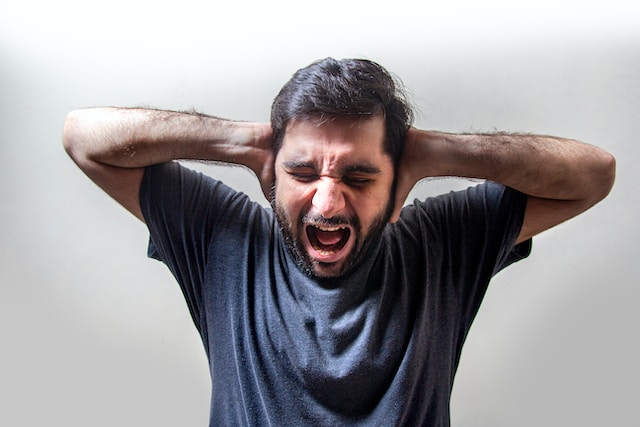Misophonia or Sound Rage

After I graduated from college, I was visiting a friend in Portland, Oregon. As we were eating dinner at his house, my fork happened to scrape across my plate with a screech. My friend winced, looking physically pained. He proceeded to tell me how much he hated that sound of scraping silverware. In response, I jokingly started to scrape my fork against the plate repeatedly. My friend was not amused and started to threaten me with physical harm if I didn’t stop. Laughing, I set my fork down, deciding it was safest to not press my luck.
While kind of a silly example, my friend’s response fits the definition of misophonia. Misophonia is the intolerance of specific types of sounds. Common sounds that cause misophonia include chewing, breathing, swallowing, foot tapping or computer typing. The sounds cause enough discomfort to be disruptive to the individual, potentially interfering with employment or social situations. In many cases, the sounds can cause hostility, anger, rage and disgust towards the person producing the sound. When anger or rage are the triggered response, misophonia is sometimes referred to as sound rage.
While data is scarce, misophonia appears to be quite common. A population study in Turkey found that 12.8% of individuals displayed symptoms. The study also found that misophonia was often quite disruptive for individuals with the condition (Kılıç 2021).
Similar Conditions
Phonophobia, or fear of sound, is a recognized phobia. It also can be considered a subcategory of misophonia. When the triggering sound produces a strong fear response, misophonia could qualify for a diagnosis of phonophobia.
Another similar condition is hyperacusis, a condition where sounds are perceived to be louder than they are, causing pain or discomfort. Hyperacusis is a neurological issue that causes the brain to amplify certain frequencies of sound. Interestingly, patients with hyperacusis can also develop misophonia, complicating its treatment (Jastreboff 2014).
Causes
Since misophonia is not an official diagnosis and was only officially described in 2001, it is not fully understood (Jastreboff 2002). We do know that misophonia is not due to damage or problems with hearing, as patients often have normal hearing upon testing. Most likely, misophonia is due to upregulated connections between the auditory system, the emotional centers of the brain and the stress response (Jastreboff 2014).
This upregulation likely occurs from conditioning that causes the characteristic emotional reaction to specific types of sounds. Conditioning is produced when two experiences become paired in the mind. The classic example is ringing a bell before giving a dog food. After repeatedly pairing a bell with food, if the bell is rung alone, it causes the dog to salivate in expectation of food. In misophonia, it is assumed that the trigger sound was paired with some form of negative experience. This pairing over time then creates the potentially disabling negative reactions to the trigger sound alone.
Treatment
Treatments for misophonia have not been well researched, although cognitive-behavioral therapy and extinction of the conditioned response have been explored. Misophonia might also be a subset of obsessive-compulsive disorder. It’s possible, but not proven that misophonia may respond to treatments for obsessive-compulsive disorder due to similarities between the conditions.
Cognitive-Behavioral Training (CBT)

An open trial using CBT found benefits for patients struggling with misophonia. CBT is a type of therapy that attempts to change distorted thoughts and behaviors while providing coping techniques to address a patient’s symptoms and concerns. For misophonia, the technique was applied through group classes that taught four separate techniques: task concentration, counterconditioning, stimulus manipulation and relaxation exercises (Schröder 2017).
- Task concentration is learning to choose the focus of your attention. The technique is similar to meditation where you focus on a specific sensory experience. Initially, the technique should be practiced in a neutral environment before it is applied to the specific sound triggers that cause strong emotional responses.
- Counterconditioning is the pairing of a strongly positive stimulus with the trigger sound. By exposing an individual to positive stimuli that cause pleasant reactions at the same time as the trigger sound, the negative conditioning response can slowly be eliminated.
- Stimulus manipulation was provided as a way for patients to feel control over the sounds in their environment. Since sound triggers in misophonia are often not under the patient’s control, this unpredictability can add to the discomfort. By having different sounds on a computer, the patient can stop or start the sounds themselves, giving a sense of control over exposure to the sound itself.
- Relaxation exercises were taught to patients since misophonia typically causes a strong stress response. Patients could use the exercises to help self-soothe. When applied consistently, these exercises can help counter the stress response that is initiated from trigger sounds.
In this initial trial of CBT treatment, almost half of patients had reduced symptoms. Patients with more severe misophonia or higher levels of disgust were more resistant to treatment (Schröder 2017).
Extinction of the Conditioned Response
The researchers who first identified misophonia developed their own treatment approach based on breaking conditioned responses. Similar to what’s described under CBT, a person struggling with misophonia finds a sound that produces a strong positive emotional response, often music. The individual should listen to the sound daily for one or two sessions totaling 30 minutes for a few weeks. During the sessions, the individual should focus on enjoying the sound—it should not be used as just background noise.
From there, the sound is then combined with situations that include the triggering noise that causes the negative reactions. The volume of the enjoyable sound can be adjusted over time to help with extinguishing the negative reaction.
While this description is an oversimplification, it touches on the basic components of the treatment. For the full description, the paper is available: Jastreboff 2014.
Conclusion
Misophonia is a common and sometimes disabling condition. While there are suggestions of potential treatments, none of the approaches are well researched. CBT and exercises to extinguish potential conditioning may hold promise, but more research is needed to better understand their application and efficacy. Obsessive-compulsive disorder treatments may also have value, but need to be researched.



